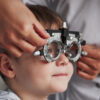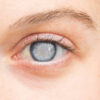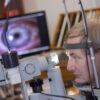While dry eye syndrome is a relatively common condition that is not usually serious and can be easy to treat, for some patients it can be extremely debilitating, with potentially life-changing consequences. Typical symptoms include sore, itchy and sometimes gritty eyes which are sensitive to light and, despite the name, produce more water than normal.
You are more likely to develop dry eye if you’re over 50, you wear contact lenses and you look at screens for a long time without a break. Some medication such as hay fever treatments and the contraceptive pill can lead to Dry Eye symptoms.
So, what exactly is Dry Eye? Well, the exact definition reads: “Dry Eye is a multifactorial disease of the ocular surface characterized by a loss of homeostasis of the tear film, and accompanied by ocular symptoms, in which tear film instability and hyperosmolarity, ocular surface inflammation and damage, and neuro-sensory abnormalities play etiological roles.”
In more simple terms, this means that changes in the amount and/or quality of your tears can lead to an unstable tear film, inflammation and increased salt in your tears. Any of these can in turn cause symptoms and damage to the front surface of your eye.
Because the cornea has more nerve endings per millimetre than anywhere else in the body, this can mean Dry Eye is painful. Our range of treatments will help to ensure a healthy environment for the front of the eye, leading to a happier, less-irritated eye.
No two patients are identical and therefore treatments are fully customised to you. After your initial assessment, a specific plan will be designed for you. The aim is to improve the quality and/or quantity of your own tears, so that you are less reliant on tear substitutes.
How you can you help yourself
Hydration – you need to keep water intake up. Coffee, tea and alcohol will dehydrate you.
Nutrition – a balanced diet is as important in Dry Eye as it is every other aspect of general health. Omega 3 rich foods such as oily fish, seeds and nuts are recommended.
Environment – Dry eyes (and skin) are more comfortable in high humidity, so try to raise the humidity around you. Humidifiers are now very easily accessible and can be compact enough to sit on a desk.
Blink – Blinking spreads the tears over the eye. Incomplete blinks will leave exposed areas, which will dry out. When people do concentrated tasks, it has been shown that their blink rate decreases.
Lid hygiene – it is very important to keep your eye lids clear of bacterial build up. Colonies can accumulate along your eye lid margins, they can then release toxins and debris which cause irritation and de-stabilise the tear film. You will need to maintain cleansing at home once or twice a day.
The above five points are the pillars of everyday dry eye management and are the foundations of the advice we would give to all dry eye patients. Some patients, however, will require a more tailored programme and we offer an in-depth assessment to create a bespoke treatment programme for you.
For more details of our specialist Dry Eye treatments visit https://www.tks-optometrists.co.uk/specialist-services/dry-eye/





